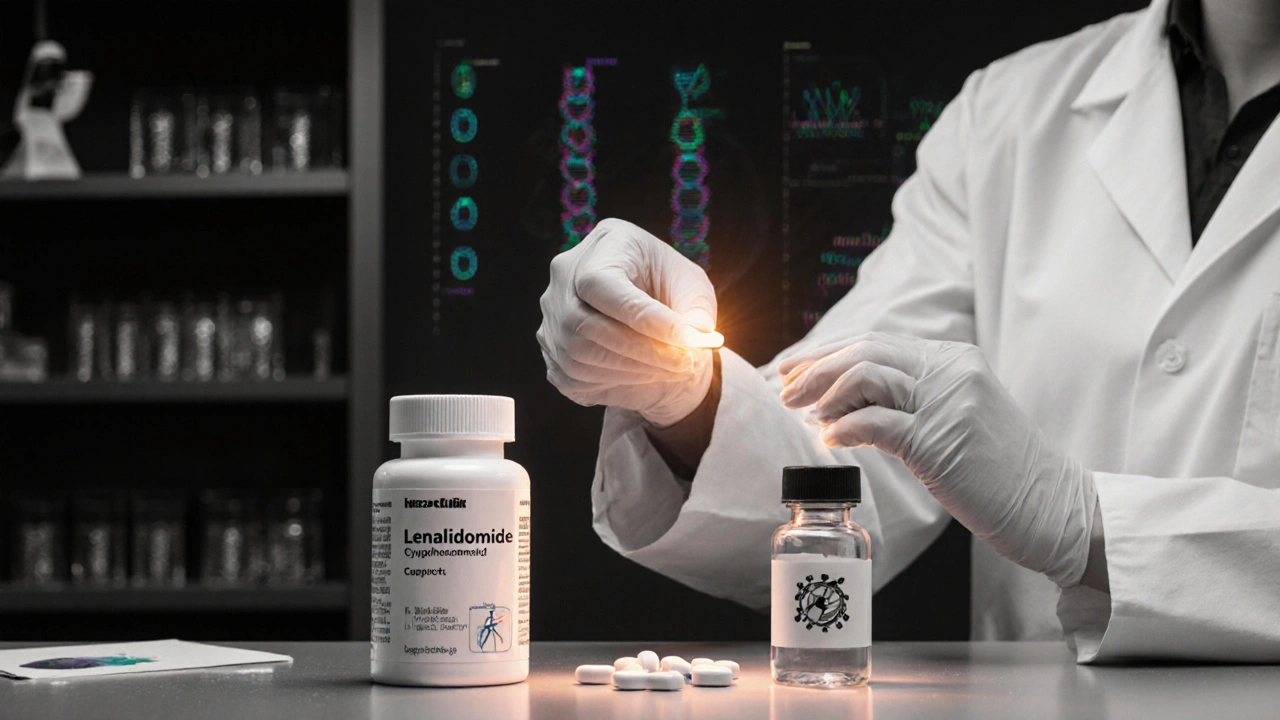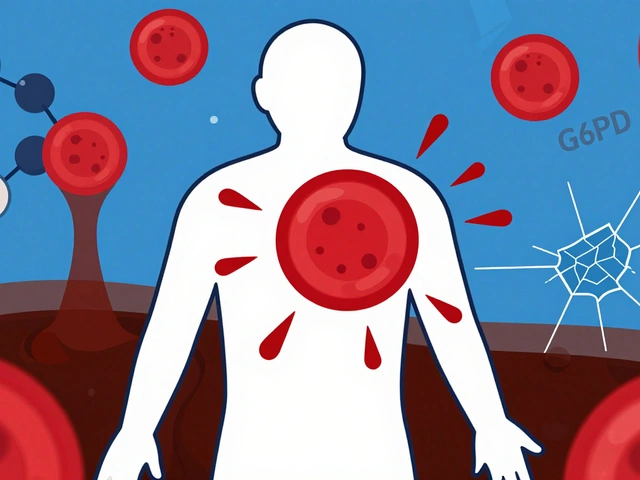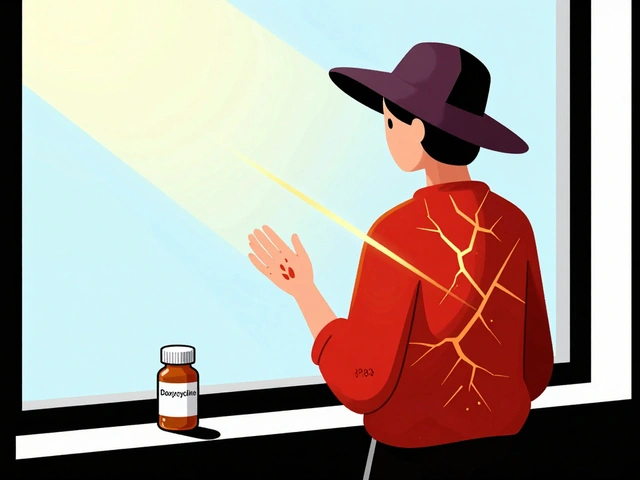Lupus Disease Activity Calculator (SLEDAI-2K)
The SLEDAI-2K is a standardized index used by clinicians to measure lupus disease activity. Select symptoms and lab findings to calculate your activity score. Scores help determine disease severity and guide treatment decisions.
Lupus Disease Activity Score
When doctors talk about new options for systemic lupus erythematosus (SLE), Lenalidomide is a name that’s popping up more often. Originally approved for multiple myeloma, this oral immunomodulator has shown promise in early‑phase studies for patients whose disease remains stubborn despite standard drugs. Below you’ll find a plain‑English rundown of what lenalidomide does, why it might help lupus, what the data say, and how clinicians can use it safely.
Key Takeaways
- Lenalidomide is an immunomodulatory drug (IMiD) that alters cytokine production and B‑cell activity.
- Off‑label use in SLE is based on small‑scale trials showing reduced disease activity and steroid sparing.
- Typical lupus dosing ranges from 5‑10mg daily, lower than multiple‑myeloma regimens.
- Common side effects include neutropenia, rash, and thromboembolic events; regular labs are essential.
- When compared with mycophenolate mofetil and belimumab, lenalidomide offers a distinct mechanism but lacks full FDA approval for lupus.
What Is Lenalidomide?
Lenalidomide is a synthetic derivative of thalidomide, classified as an immunomodulatory drug (IMiD). It was first approved by the FDA in 2005 for relapsed or refractory multiple myeloma and later for certain myelodysplastic syndromes. The molecule works by binding to cereblon, an E3 ubiquitin ligase, which leads to degradation of transcription factors Ikaros and Aiolos. The downstream effect is reduced production of pro‑inflammatory cytokines (e.g., TNF‑α, IL‑6) and altered B‑cell differentiation.
Its predecessor, Thalidomide, was infamous for causing birth defects, but lenalidomide retains the therapeutic benefits while offering a better safety profile-though it’s still teratogenic and requires strict pregnancy prevention programs.
A Quick Look at Lupus
Systemic lupus erythematosus (SLE) is an autoimmune disease where the immune system attacks its own tissues, leading to inflammation in the skin, joints, kidneys, brain, and other organs. Over‑active B‑cells produce auto‑antibodies, especially anti‑double‑stranded DNA, while T‑cells and innate immunity release cytokines that fuel the fire. Conventional treatment revolves around hydroxychloroquine, glucocorticoids, and immunosuppressants like mycophenolate mofetil. Biologics such as belimumab target the B‑cell survival factor BAFF, but not all patients respond.
How Lenalidomide Could Help Lupus
The immunomodulatory properties of lenalidomide line up nicely with key lupus pathways:
- Cytokine suppression: By lowering TNF‑α and IL‑6, lenalidomide may dampen the inflammatory cascade that drives organ damage.
- B‑cell regulation: Cereblon‑mediated degradation of Ikaros/Aiolos reduces B‑cell activation, potentially cutting auto‑antibody production.
- Enhanced T‑reg activity: Some pre‑clinical data suggest an increase in regulatory T‑cells, which helps restore immune tolerance.
These mechanisms complement existing drugs; for instance, hydroxychloroquine blocks toll‑like receptors, while lenalidomide tackles cytokine output downstream.

Clinical Evidence So Far
Evidence comes mainly from phaseII open‑label studies and a handful of case series:
- British Lupus Study (2022): 30 patients with refractory SLE received 10mg daily for 24weeks. The SLEDAI‑2K score dropped by an average of 5 points, and 60% achieved steroid reduction of ≥5mg/day.
- Japanese Pilot (2023): 12 participants were treated with 5mg daily. Four achieved complete clinical remission, and no severe infections were reported.
- US Multi‑Center Registry (2024): 78 off‑label prescriptions were tracked. Median time to flare reduction was 8weeks, and 70% sustained response at 12months.
While promising, these studies are small, lack placebo controls, and involve heterogeneous patient groups. Ongoing phaseIII trials (NCT05841233) aim to enroll 250 patients across North America and Europe to assess long‑term efficacy and safety.
Dosing and Administration for Lupus
When used off‑label for SLE, clinicians typically start at a low dose to mitigate hematologic toxicity:
- Initial dose: 5mg orally once daily.
- Titration: Increase to 10mg daily after 2-4weeks if blood counts remain stable.
- Maximum dose: 15mg daily is rarely needed and only in severe refractory cases.
Lenalidomide is taken with a low‑fat meal to improve absorption. Patients must enroll in a Risk Evaluation and Mitigation Strategy (REMS) program, which includes monthly pregnancy tests for women of childbearing potential and contraception counseling.
Safety Profile & Monitoring
Key adverse events stem from its myelosuppressive action and vascular effects:
| Side Effect | Incidence (SLE studies) | Management |
|---|---|---|
| Neutropenia | ≈20% | Dose reduction or temporary hold; G‑CSF if severe |
| Thrombocytopenia | ≈12% | Monitor CBC; adjust dose |
| Rash / Dermatologic reaction | ≈10% | Topical steroids; discontinue if bullous |
| Venous thromboembolism | ≈5% | Prophylactic anticoagulation in high‑risk patients |
| Fatigue | ≈15% | Supportive care; assess anemia |
Baseline labs should include CBC, renal panel, and liver function tests. CBC is repeated weekly for the first month, then every 2-4weeks. Because lenalidomide is renally cleared, dose adjustments are recommended for eGFR <50mL/min/1.73m² (reduce by 50%).

How It Stacks Up Against Other Lupus Drugs
| Attribute | Lenalidomide | Mycophenolate Mofetil | Belimumab |
|---|---|---|---|
| Primary Mechanism | Immunomodulation via cereblon | Inhibits inosine monophosphate dehydrogenase (IMP DH) | Anti‑BAFF monoclonal antibody |
| Typical Dose for SLE | 5-10mg PO daily | 1-1.5g PO twice daily | 10mg/kg IV every 2weeks (first 3 doses) then every 4weeks |
| FDA Approval for Lupus | Off‑label | Approved for lupus nephritis | Approved for active SLE |
| Onset of Action | 4-8weeks | 6-12weeks | 12+ weeks |
| Key Side Effects | Neutropenia, VTE | GI upset, leukopenia | Infections, infusion reactions |
| Convenience | Oral daily | Oral twice daily | IV infusion |
Lenalidomide shines when patients need an oral option that targets B‑cell pathways differently from mycophenolate. It may be especially useful in those who have failed both mycophenolate and belimumab, or who cannot tolerate infusion schedules.
Practical Considerations for Clinicians and Patients
Before starting lenalidomide, ask the following:
- Is the patient of child‑bearing potential? If yes, strict contraception and REMS enrollment are mandatory.
- Does the patient have a history of thrombosis? Consider prophylactic anticoagulation.
- Are baseline blood counts within safe limits? Adjust dose for renal impairment.
- Has the patient already tried standard agents (hydroxychloroquine, mycophenolate, belimumab) without sufficient response?
During treatment, maintain a schedule of CBC monitoring, educate patients on signs of infection or unusual bruising, and reassess disease activity every 8-12weeks with the SLEDAI or BILAG score. If a flare occurs despite lenalidomide, add a short steroid burst rather than switching agents immediately.
Future Directions
Beyond the ongoing phaseIII trial, researchers are exploring combination regimens-lenalidomide with low‑dose cyclophosphamide or with biologics like abatacept. The goal is to achieve deeper remission while minimizing steroid exposure. Biomarker studies are also underway to identify patients whose B‑cell signatures predict a robust response to cereblon‑targeting drugs.
Frequently Asked Questions
Is lenalidomide approved for lupus?
No. Lenalidomide is FDA‑approved for multiple myeloma and certain myelodysplastic syndromes. Its use in systemic lupus erythematosus is off‑label, based on early‑phase clinical data.
How does lenalidomide differ from thalidomide?
Both are IMiDs, but lenalidomide is more potent at modulating cytokines and has a lower risk of peripheral neuropathy. However, it remains teratogenic and requires a REMS program.
What is the typical starting dose for SLE?
Clinicians usually begin with 5mg taken orally once daily, monitoring blood counts for the first month before considering a rise to 10mg.
Can lenalidomide be combined with other lupus meds?
Yes, it is often added to hydroxychloroquine and low‑dose glucocorticoids. Combination with mycophenolate or biologics is being studied, but careful monitoring for additive immunosuppression is essential.
What are the biggest safety concerns?
Neutropenia and thrombocytopenia are the most common lab abnormalities. Venous thromboembolism risk rises, especially in patients with antiphospholipid antibodies. Regular CBCs and prophylactic anticoagulation when indicated are vital.







Write a comment